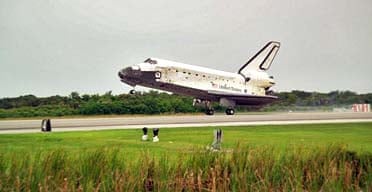Nasa hailed the rebirth of its human space flight programme last night after the shuttle Discovery and six astronauts capped a near-flawless 13-day mission with a picture-perfect landing at the Kennedy Space Centre.
The space agency believes that the success of the 5.3m-mile journey has finally enabled it to emerge from the gloom after the 2003 Columbia disaster and complete construction of the International Space Station. Such a scenario was unthinkable before Discovery's July 4 launch, when Nasa's managers were at odds over the integrity of the ageing fleet and safety officers called for an immediate fuel tank redesign to avoid a repeat of the accident that killed Columbia's crew of seven.
"We're ready to go fly shuttles on a regular basis," said Discovery's commander, Steve Lindsey, after guiding the orbiter to the first landing at Cape Canaveral since 2002. "We are back to space station assembly, and flying space shuttle flights, but we can't ever let our guard drop."
Discovery touched down at 9.14am (2.14pm BST) after the storm clouds that threatened to delay its return remained outside the 30-mile danger zone. As the crew, including the British astronaut Piers Sellers, underwent medical checks, Discovery was powered down and prepared for the journey to its processing hangar.
The flight included three spacewalks by Dr Sellers and the American astronaut Mike Fossum, who tested the load-bearing capabilities of the orbiter's robotic arm. During one of the spacewalks Dr Sellers dropped a spatula, which is now orbiting the earth at 17,500mph.
Dr Sellers described the sensation of bouncing on the end of the robotic arm with Mr Fossum: "It felt like two very fat guys on a telephone pole hanging on to a hat stand," he said. "It was crowded out there. I was looking back down three skinny sections of sewer pipe connecting me to the space shuttle, and looking through tiny windows where warm, safe people were waving at me."
He also joked about the moment the tool went spinning off into space. "The spatula was a bad moment because it was my favourite one," he said. "But don't tell the other spatulas".
Nasa has a rigid 2010 deadline for retiring its remaining orbiters, and must complete 16 missions in little more than four years to meet its goals. While that timetable pales compared with the pre-Columbia schedule of seven to nine flights a year, Nasa must achieve it with only three orbiters. Endeavour will not be flight-ready until next year after a lengthy refit; Atlantis is due for its first liftoff in four years on August 28, and ground crews will have to work quickly to turn Discovery around for a December launch.
Agency managers say they have still to fix the problem of insulation foam falling from the fuel tank at liftoff and damaging the shuttle. The problem that ultimately caused Columbia to disintegrate happened again during Discovery's first return-to-flight mission last summer, grounding the fleet for a further year.
But the latest mission was a turning point. Among the safety improvements successfully tested were enhanced video scrutiny of the launch, which enabled engineers to give Discovery's thermal protection shield a clean bill of health.
More than seven tonnes of supplies and equipment were also delivered to the space station. Despite the mission's success, Nasa administrator Mike Griffin said the space agency would not become overconfident. "The words 'routine human spaceflight' do not belong in the same sentence," he said. "But after Columbia, the nation vowed to return the shuttle to flight and to the space station. It was a controversial decision but we have kept to that path."
